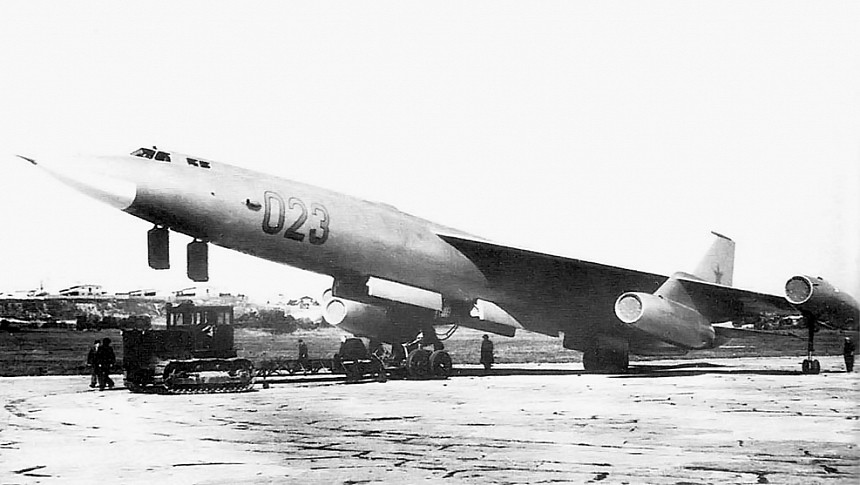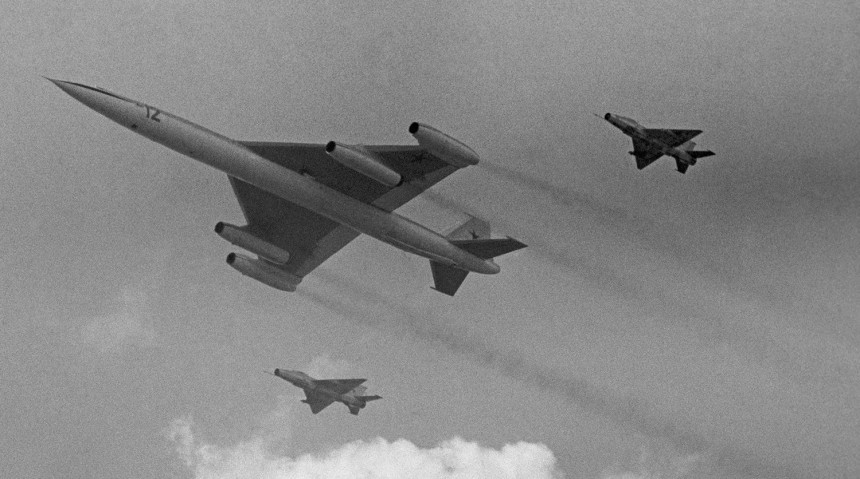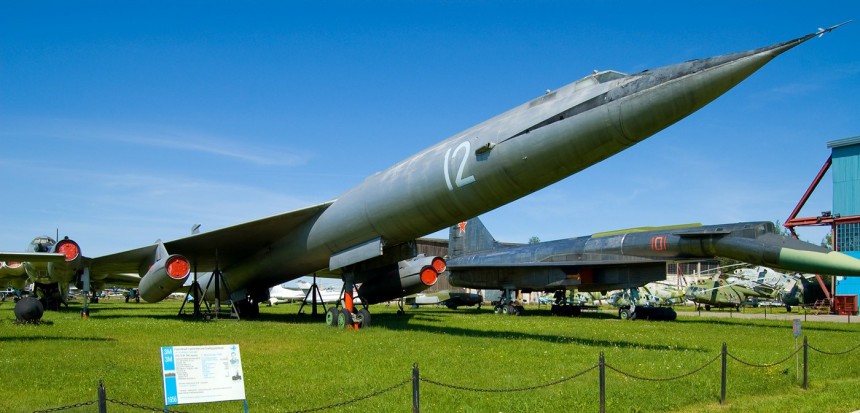At the height of the Cold War, the Soviet Union was doing everything it could to gain the upper hand over the United States. One area where it was attempting to do this was in the supersonic bomber segment after learning that such an aircraft was under development in the USA. The Soviets came up with the Myasishchev M-50, NATO codename Bounder. The M-50 startled the United States when it first appeared and created a hoax about whether the aircraft was actually nuclear-powered.
While the hoax was soon exposed, the M-50s development pressed on. But the USA would quickly learn that the M-50 represented no real threat, and only one was ever built and flown. The later M-52, a much more advanced version, never flew after one aircraft was built.
The M-50 would have almost the exact dimensions and weight of the M-4 but feature a slender fuselage and delta wing plus a swept tail. Four engines were chosen, with them mounted in pods under the wings and at the wingtips. A vastly reduced crew to two was also a feature, compared to the eight of the M4, to help keep the weight of the M-50 down. The new bomber promised a giant leap over what came before it. On paper, things definitely looked promising. Its 35-meter delta wing was also the largest ever built. But flight testing didn't go quite as hoped.
The M-50 featured eight fuel tanks within the fuselage area, and a pressurized cockpit had downward-firing ejection seats for the pilot and co-pilot. Many of the systems within the M-50 were automated to make the workload more straightforward, and there was even the potential for a remotely operated tail gun to help defend the aircraft. The plan was to have the M-50 capable of carrying nuclear bombs or cruise missiles. When it was finished in 1958, it looked like the Soviet Union had developed a genuinely world-beating aircraft.
That same year, the magazine Aviation Week reported that the Soviets were flight-testing the world's first nuclear-powered aircraft. They claimed that multiple credible sources said that the bomber had incredible capabilities, such as the ability to fly around the world multiple times without refueling. Newspapers and news outlets picked up on the story, spreading panic in the USA as to how far the country could have fallen behind. Most Western intelligent experts doubted the claims of the magazine, but the development of the M-50 was still shrouded in mystery. So there was a slim chance the rumors were true. But it was soon exposed as a hoax.
The aircraft's shape wasn't particularly aerodynamic either, with drag something the bomber would suffer from throughout flight testing. Pressure from Soviet leaders saw the development of the M-50 badly compromised, and the aircraft proved a challenge to fly as well as severely underpowered.
With effectively the same Dobrynin engines as the M-4, the aircraft simply could not cross the sound barrier. At full power and in a dive, the aircraft could not break Mach 1. The Soviet Union curtailed the development of the aircraft after just 11 test flights, which led to Myasishchev developing the faster, more aerodynamic M-52. But even that wouldn't be enough for Soviet leaders.
Before the new M-52 could even take to the skies, the entire project was shelved. Interest in the aircraft had dwindled, and intercontinental ballistic nuclear missiles proved a cheaper and quicker way of delivering a nuclear payload. While the M-52 was completed, it never flew, and the program was shelved for good in 1961. Remarkably, the one built M-50 survives to this day, on display at the Monino Aviation Museum.
It was certainly one of the most striking-looking aircraft of the Cold War. And it led to fears of a nuclear-powered supersonic bomber that was ultimately nothing more than the work of pure fiction.
Why the Soviet Union needed the M-50
The Soviets learned that a next-generation bomber was coming from the USA, an aircraft that would lead to the ill-fated XB-70 program. With the American bomber project looming over them, the Soviet Union knew it had to develop a counterpart. This task fell to the Myasishchev company, which would be asked to build a Mach 2 bomber to counter anything the Americans were building. Myasishchev had already made a bomber aircraft in the form of their subsonic M-4. But this would be a different ballgame altogether.The M-50 would have almost the exact dimensions and weight of the M-4 but feature a slender fuselage and delta wing plus a swept tail. Four engines were chosen, with them mounted in pods under the wings and at the wingtips. A vastly reduced crew to two was also a feature, compared to the eight of the M4, to help keep the weight of the M-50 down. The new bomber promised a giant leap over what came before it. On paper, things definitely looked promising. Its 35-meter delta wing was also the largest ever built. But flight testing didn't go quite as hoped.
The M-50 bomber creates a stunning nuclear bomber hoax
That same year, the magazine Aviation Week reported that the Soviets were flight-testing the world's first nuclear-powered aircraft. They claimed that multiple credible sources said that the bomber had incredible capabilities, such as the ability to fly around the world multiple times without refueling. Newspapers and news outlets picked up on the story, spreading panic in the USA as to how far the country could have fallen behind. Most Western intelligent experts doubted the claims of the magazine, but the development of the M-50 was still shrouded in mystery. So there was a slim chance the rumors were true. But it was soon exposed as a hoax.
Testing proved that the M-50 was severely underpowered
It was in 1961 that the M-50 was finally shown off to the public, displayed at that year's Soviet Airshow. But its unveiling left Western observers with even more questions. For starters, the absence of inlet centerbodies on the engines hinted at a lack of any supersonic capabilities.The aircraft's shape wasn't particularly aerodynamic either, with drag something the bomber would suffer from throughout flight testing. Pressure from Soviet leaders saw the development of the M-50 badly compromised, and the aircraft proved a challenge to fly as well as severely underpowered.
With effectively the same Dobrynin engines as the M-4, the aircraft simply could not cross the sound barrier. At full power and in a dive, the aircraft could not break Mach 1. The Soviet Union curtailed the development of the aircraft after just 11 test flights, which led to Myasishchev developing the faster, more aerodynamic M-52. But even that wouldn't be enough for Soviet leaders.
The M-50 program ends in disgrace
It was certainly one of the most striking-looking aircraft of the Cold War. And it led to fears of a nuclear-powered supersonic bomber that was ultimately nothing more than the work of pure fiction.













